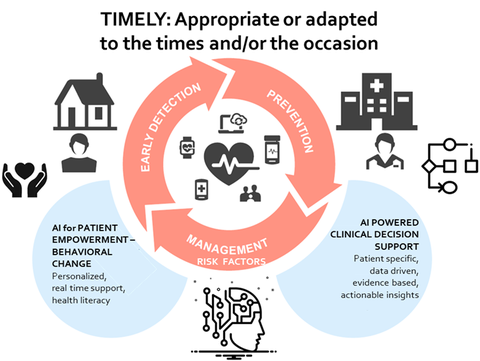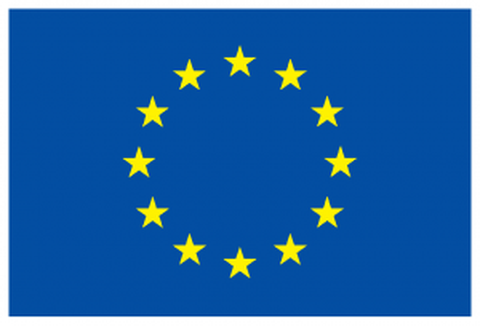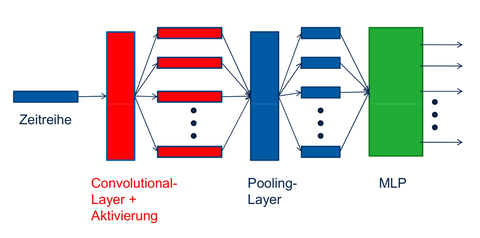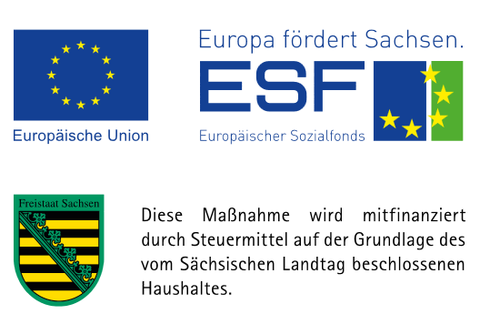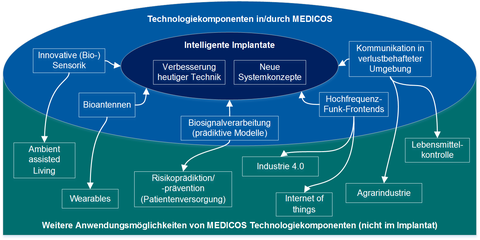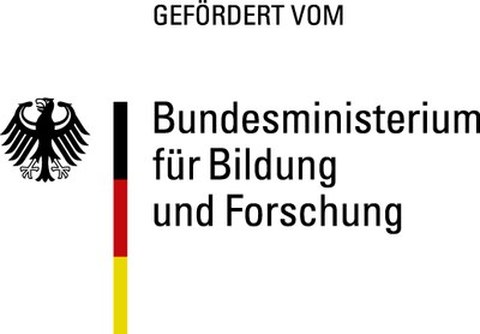Arbeitsgruppe Biosignalverarbeitung
Inhaltsverzeichnis
Überblick
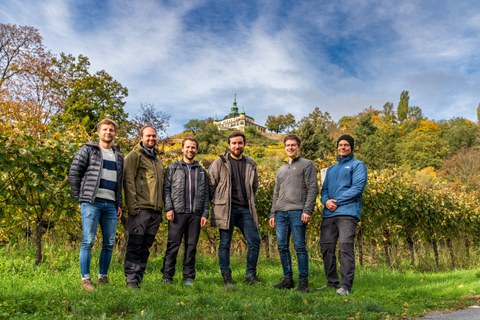
Unsere AG auf Tour, Herbst 2023: M. Schmidt, R. Hohmuth, A. Hammer, M. Scherpf, H. Ernst and Marc Göttling (von links nach rechts).
Die Arbeitsgruppe Biosignalverarbeitung befasst sich mit der Entwicklung neuer innovativer Methoden zur Analyse von Biosignalen, um eine Verbesserung heute verfügbarer diagnostischer und therapeutischer Verfahren sowie neue medizintechnischer Lösungen zu erzielen.
Gemeinsam mit klinischen und nicht-klinischen Partnern aus Forschung und Industrie arbeitet die Arbeitsgruppe Biosignalverarbeitung in nationalen und internationalen Projekten, die alle Bereiche von der Grundlagenforschung über klinische Studien bis hin zum anwendungsnahen Entwicklungsprojekt abdecken.
Anwendungen der entwickelten Verfahren und Methoden liegen im klinischen Bereich, z. B. in der Kardiologie, Intensiv-, Schlaf- und Pränatalmedizin. Daneben werden auch zukunftsweisende außerklinische und nicht-medizinische Anwendungen, z. B. Ambient Assisted Living und Sportmonitoring verfolgt.
Folgen Sie uns auf LinkedIn!
Mitarbeit
Interessenten haben jederzeit im Rahmen von Studien-, Diplom- und Masterarbeiten (ET, INF, MT, WING), Forschungsprojekten (INF, CMS) oder über WHK/SHK Tätigkeiten die Möglichkeit zur Mitarbeit an den Forschungsthemen und aktuellen Projekten der Arbeitsgruppe. Konkrete Anfragen richten Sie an Herrn Dr.-Ing. Martin Schmidt (Kontakt siehe unten).
Unsere Themensammlung für Studien- und Diplomarbeiten als PDF
Individuelle Themenvorschläge im Rahmen der Projekte der Arbeitsgruppe sind jederzeit möglich und willkommen. Konkrete Anfragen richten Sie an Herrn Dr.-Ing. Martin Schmidt (Kontakt siehe unten).
Aktuelle Themen umfassen:
- Untersuchungen zur kamerabasierten Erfassung von Vitalparametern
- Charakterisierung hämodynamischer Parameter mittels kamerabasierter Messungen
- Physiologische Netzwerke – Untersuchung von Organinteraktionen mittels Kopplungsanalyse von Biosignalen
- Prädiktion kardiovaskulärer Erkrankungen mittels interpretierbarer künstlicher Intelligenz
- Analyse von Hirnpulskurven aus transkraniellen Ultraschallmessungen mit Methoden der künstlichen Intelligenz
- Physiologische Netzwerke – Untersuchung von Regelungsmechanismen während der Schwangerschaft
- Weiterentwicklung und Nutzung der QT-Analyse
Detaillierte Informationen finden Sie in unserer Themensammlung für Studien- und Diplomarbeiten als PDF
Ausgewählte Projekte
Die koronare Herzkrankheit (KHK) ist eine der führenden Todesursachen in westlichen Industrieländern. Dabei handelt es sich um eine Verengung oder auch Verkalkung von Adern, die das Herz mit Sauerstoff versorgen. Die Krankheit entwickelt sich langsam, in der Regel über Jahrzehnte hinweg und hängt von mehreren (oft veränderbaren) Risikofaktoren und deren Wechselwirkungen ab. Selbstmanagement und Lebensweise des Patienten sowie rechtzeitige klinische Interventionen können die Entwicklung der KHK wesentlich beeinflussen. Deshalb sind Früherkennung bzw. Verhinderung des Fortschreitens der Krankheit essentiell. Die Bereitstellung qualitativer Sekundärprävention für alle Herzpatienten ist jedoch aufgrund der Beschränkungen des Gesundheitsbudgets eine große Herausforderung.
Genau hier will das Projekt „A patient-centered early risk prediction, prevention, and intervention platform to support the continuum of care in coronary artery disease using eHealth and artificial intelligence (TIMELY)” ansetzen und eine patientenzentrierte eHealth-Plattform aufbauen. Unterstützt durch KI soll die TIMELY-Plattform kontinuierlich und zeitnah kardiale Risiken und Komplikationen individuell prognostizieren. Die dadurch möglichen gezielten Interventionen werden das Risiko- und Symptommanagement verbessern. Auf diese Weise soll die Sekundärprävention von KHK wirksam und kosteneffizient werden und damit die physiologischen und psychologischen Auswirkungen der Erkrankung minimieren. TIMELY soll Patienten und Klinikern helfen, die Gesundheitsversorgung auf der Grundlage einer Risikobewertung zu personalisieren sowie die Ergebnisprognose und maßgeschneiderte Interventionen zu verbessern.
TIMELY wird die KI-basierten Algorithmen für Datenpräsentationen und Entscheidungsunterstützung integrieren. Sie wird auf der Grundlage einer funktionalen Plattform entwickelt, welche die Interoperabilität mit elektronischen Gesundheitsakten und Sicherheitsmechanismen berücksichtigt. So kann die Vollständigkeit und Kontinuität der Informationen gewährleistet und der Datenaustausch vereinfacht werden. Die KI in TIMELY, die mit großen retrospektiven Datensätzen von über 23.000 KHK-Patienten erstellt wird, kann ständig Risiken überwachen, bewerten, jede Abweichung von definierten Therapiezielen oder ungünstige Veränderungen anzeigen sowie angemessene Interventionen vorschlagen.
TIMELY wird im Rahmen des Horizont 2020 - Programms für Forschung und Innovation der Europäischen Union unter der Fördervereinbarung ID: 101017424 über drei Jahren gefördert. Das Projektvolumen beträgt 5,7 Millionen Euro. Weitere Informationen finden Sie auf der Projektwebsite.
Das autonome Nervensystem (ANS) kontrolliert zahlreiche Körperfunktionen und zeigt je nach persönlichem Zustand spezifische Reaktionen. Die Bewertung des ANS erlaubt daher weitreichende Aussagen, beispielsweise zum Risiko lebensbedrohliche Erkrankungen zu erleiden, eine Bewertung des Schlafs und die Erfassung der Stressbelastung.
Die Arbeitsgruppe Biosignalverarbeitung entwickelt Methoden der Signalverarbeitung, um derartige Aussagen treffen zu können. Neben der heute etablierten Analyse der Herzratenvariabilität richten sich die eigenen Arbeiten beispielsweise auf die QT-Variabilität. Zu deren Bewertung wurden und werden innovative Ansätze entwickelt. Ziel ist eine wesentliche Verbesserung der diagnostischen Möglichen, insbesondere auch die Prädiktion und Prävention, ohne dass für die Patienten eine zusätzliche Belastung entsteht.
Im Rahmen des Projektes wird eine enge Kooperation mit der Arbeitsgruppe von Prof. Mathias Baumert (The University of Adelaide) gepflegt. Weitere Informationen zum Projekt sind auf der Website des Two-Dimensional Signal Warping (2DSW) zu finden.

Schema des Two-Dimensional Signal Warping (2DSW, siehe auch http://2dsw.com/).
Weiterführende Literatur
-
M. Schmidt, M. Baumert, T. Penzel, H. Malberg, und S. Zaunseder, „Nocturnal ventricular repolarization lability predicts cardiovascular mortality in the Sleep Heart Health Study“, American Journal of Physiology-Heart and Circulatory Physiology, Bd. 316, Nr. 3, S. H495–H505, Dez. 2018, doi: 10.1152/ajpheart.00649.2018.
-
M. Schmidt, M. Baumert, H. Malberg, und S. Zaunseder, „T Wave Amplitude Correction of QT Interval Variability for Improved Repolarization Lability Measurement“, Front. Physiol., Bd. 7, 2016, doi: 10.3389/fphys.2016.00216.
-
M. Schmidt, M. Baumert, H. Malberg, und S. Zaunseder, „Iterative two-dimensional signal warping—Towards a generalized approach for adaption of one-dimensional signals“, Biomedical Signal Processing and Control, Bd. 43, S. 311–319, Mai 2018, doi: 10.1016/j.bspc.2018.03.016.
-
M. Schmidt, M. Baumert, A. Porta, H. Malberg, und S. Zaunseder, „Two-Dimensional Warping for One-Dimensional Signals—Conceptual Framework and Application to ECG Processing“, IEEE Transactions on Signal Processing, Bd. 62, Nr. 21, S. 5577–5588, Nov. 2014, doi: 10.1109/TSP.2014.2354313.
Besonders in der Schlafmedizin, aber auch in außerklinischen Anwendungen spielt die Bewertung der Schlafqualität eine zentrale Rolle. Die Arbeitsgruppe Maschinelles Lernen beschäftigt sich in diesem Kontext mit der automatisierten Klassifikation von Schlafstadien, der Detektion schlafbezogener Atem- und Schlafstörungen bis hin zur automatisierten Ableitung von Handlungsempfehlungen. Zum Einsatz kommen dabei moderne Methoden der Mustererkennung, des maschinellen Lernens (ML) und der künstlichen Intelligenz (KI).
Im Rahmen des Forschungsprojekts Teleschlafmedizin entwickelt die Arbeitsgruppe in diesem Zusammenhang zusammen mit Partnern aus der Klinik und der Industrie eine telemedizinische Plattform für die Schlafmedizin. Das Projekt umfasst dabei drei wesentliche Entwicklungsschwerpunkte:
- Weiterentwickelung, Anpassung und Validierung kontaktloser medizinischer Messtechnik für schlafmedizinische Anwendungen.
- Zusammenführung verschiedene diagnostischer und therapeutischer Biosignale und Daten aus der Schlafmedizin in einer gemeinsamen medizinischen Datenbank (Datenintegration). Dies betrifft sowohl polysomnographische Daten aus der Klinik für Neurologie, also auch Überwachungsdaten aus dem häuslichen Umfeld.
- Entwicklung eines telemedizinischen Systems, das mittels KI-Methoden die Datenanalyse automatisiert, wesentlich vereinfacht und damit praxistauglich macht.
Das Projekt wird mit Mitteln des Europäischen Fonds für regionale Entwicklung (EFRE) gefördert.
Ziel der MEDICOS-Nachwuchsforscher ist es, hochinnovative Methoden zur Energiereduzierung in intelligenten Implantaten zu entwickeln. Das beinhaltet die Konzeption und Umsetzung neuer Strategien für minimal-invasive und gleichzeitig hoch performante, biokompatible Signalverarbeitungs- und -Übertragungssysteme. Im Hinblick auf die Umsetzung und den Einsatz intelligenter Implantate besteht heute vielschichtiger Forschungs- und Entwicklungsbedarf. Maßgebliche Forschungs- und Entwicklungsaktivitäten zu intelligenten Implantaten umfassen neben einer Verkleinerung, höheren Bioverträglichkeit und Langzeitstabilität vor allem eine bessere Datenanbindung und Implantatvernetzung. Gerade vor dem Hintergrund, dass mehr Informationen erfasst werden sollen, eine Einheit von Diagnose und Therapie angestrebt ist und lange Lebenszeiten gefordert werden, genügen die vorhandenen Systeme weder in der inhaltlichen Performance noch in der Energieeffizienz den gestellten Anforderungen. Um das diagnostische und therapeutische Potential intelligenter Implantate voll zu erschließen, müssen daher hochenergieeffiziente und performante minimal und nicht-invasive Systeme entwickelt werden. Genau das ist das Ziel der Forschergruppe MEDICOS. MEDICOS möchte extrem energieeffiziente, adaptive, drahtlose Biosignalverarbeitungs- und Kommunikationssysteme entwickeln, welche genügend Performance bieten, um komplexe Biosignale verarbeiten zu können und den invasiven Eingriff auf ein Minimum reduzieren.
Die Zuwendung wird aus Mitteln des Europäischen Sozialfonds (ESF) und aus Steuermitteln auf Grundlage des von den Abgeordneten des Sächsischen Landtags beschlossenen Haushaltes zur Verfügung gestellt.
Ziel im Projekt fast athletics ist die Optimierung der biomechanischen und sportphysiologischen Echtzeit-Leistungsdiagnostik im Freizeit- und Spitzensport für den bewegungsgesteuerten Selbstausbildungsprozess und für den Broadcast durch die Integration
- neuer körpernaher Sensorinfrastrukturen und Steuerungsprinzipien und
- neue Trainingsmethoden für die sensorische Wahrnehmung und Bewegungssteuerung.
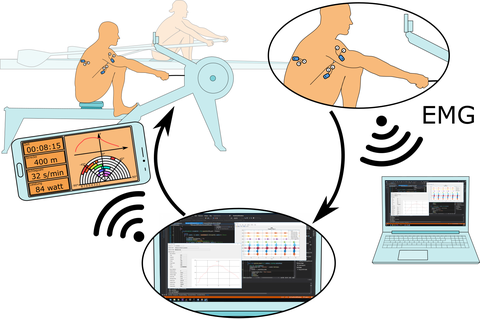
Schematische Darstellung des im Projekt geplanten Biofeedbacks im Rudersport.
Das Teilvorhaben verfolgt das Ziel, die technischen und sportphysiologischen Grundlagen (Methoden, Systeme, Erkenntnisse) eines echtzeitfähigen physiologischen Biofeedbacks (Schwerpunkt Echtzeit-Elektromyogramm, Echtzeit-EMG) zur Optimierung des Trainings bei Sportarten mit zyklisch ausgeführten Bewegungen, wie Rudern, Langlauf oder Fahrradfahren, zu legen. Dazu wird eine prototypische Realisierung für das Ruderergometer umgesetzt und evaluiert.
Partner im Verbundprojekt:
Weitere Informationen finden Sie auf der Projektwebsite
Die Möglichkeiten der fetalen Diagnostik sind heute äußerst begrenzt. Insbesondere mangelt es an Verfahren, die nicht-invasiv und einfach anwendbar, ggf. auch außerklinisch und über längere Zeiträume, den fetalen Gesundheitszustand erfassen können.
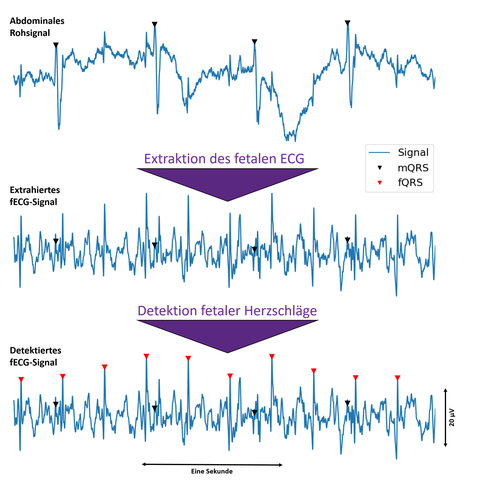
Extraktion des fetalen EKG und Extraktion der fetalen Herzschläge (fQRS).
Das fetale Elektrokardiogramm (fEKG) mittels abdominaler Elektroden bietet eine derartige Möglichkeit. Dabei werden die elektrischen Signale vom Bauch der Mutter erfasst. Das Ergebnis ist eine Mischung aus fetalem EKG, mütterlichem EKG und Rauschen. Die korrekte Extraktion des fEKG ist bis heute problematisch.
Dieses Problem der Quellentrennung konnte in der Arbeitsgruppe auf einem international hohen Niveau gelöst werden. Dieser Erfolg wird insbesondere in zwei ersten Plätzen der Computing in Cardiology Challenge 2013 deutlich. Weitere Forschungsergebnisse zur Simulation, Extraktion und Qualitätsbewertung von fetalen EKG-Daten wurden in einer Toolbox (FECGSYN) zusammengeführt.
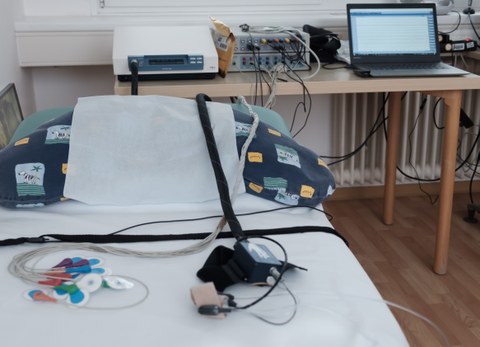
Gerätetechnik zur Erfassung des fetalen EKG.
Seit 2018 finden die Arbeiten im Rahmen des DFG-Projektes „Erweitertes Fetalmonitoring“ statt. Dazu wird unter anderem eine große Datenbank longitudinaler Aufzeichnungen während der Schwangerschaft in Kooperation mit dem Universitätsklinikum Leipzig und der Humbold Universität Berlin aufgebaut und hinsichtlich Risikomarkern für die fetale Gesundheit untersucht.
Der Schwerpunkt zukünftiger Arbeiten umfasst die Entwicklung innovativer Algorithmen zur Extraktion des fEKG. Die Inhalte des fEKG werden detailliert untersucht, um fEKG-basierte Marker der fetalen Entwicklung zu identifizieren. Außerdem werden neuartige Monitoringverfahren und -systeme für den klinischen und außerklinischen Bereich angestrebt. So soll mit einfacher Hardware, z.B. integriert in Smartphones, zukünftig eine Abschätzung des fetalen Risikos möglich werden.
WEITERFÜHRENDE LITERATUR
- J. Weiß, H. Malberg, und M. Schmidt, „Detection Quality Indices for Improved Heart Beat Assessment in Non-Invasive Fetal ECG“, in 2020 Computing in Cardiology, Sep. 2020, S. 1–4, doi: 10.22489/CinC.2020.231.
-
F. Andreotti, F. Gräßer, H. Malberg, und S. Zaunseder, „Non-invasive Fetal ECG Signal Quality Assessment for Multichannel Heart Rate Estimation“, IEEE Transactions on Biomedical Engineering, Bd. 64, Nr. 12, S. 2793–2802, Dez. 2017, doi: 10.1109/TBME.2017.2675543.
-
J. Behar, F. Andreotti, S. Zaunseder, J. Oster, und G. D. Clifford, „A practical guide to non-invasive foetal electrocardiogram extraction and analysis“, Physiol. Meas., Bd. 37, Nr. 5, S. R1–R35, Apr. 2016, doi: 10.1088/0967-3334/37/5/R1.
-
F. Andreotti, J. Behar, S. Zaunseder, J. Oster, und G. D. Clifford, „An open-source framework for stress-testing non-invasive foetal ECG extraction algorithms“, Physiol. Meas., Bd. 37, Nr. 5, S. 627–648, Apr. 2016, doi: 10.1088/0967-3334/37/5/627.
Partner
Die AG Biosignalverarbeitung arbeitet mit zahlreichen Partnern aus Forschung und Industrie zusammen. Dies umfasst auch enge Kooperationen zu mehreren Kliniken.
Da die Internationalisierung ein wesentliches Anliegen ist, wurden in den letzten Jahren auch mehrere internationale Kooperationen, beispielsweise mit der University of Adelaide (Australien), der Florida State University (USA), der University of Oxford (Großbritannien) und der Umea University (Schweden), initiiert und etabliert. Industriekooperationen bestehen unter anderen mit den Firmen BIOTRONIK SE & Co. KG und der Sonovum GmbH.
Kontakt und weitere Informationen
 © IBMT
© IBMT
Arbeitsgruppenleiter
NameHerr Dr.-Ing. Martin Schmidt
AG Biosignalverarbeitung
Eine verschlüsselte E-Mail über das SecureMail-Portal versenden (nur für TUD-externe Personen).
Besuchsadresse:
Fetscherforum (F29), 1.OG, Raum 34 Fetscherstraße 29
01307 Dresden
Aktuelle Veröffentlichungen
2021
-
Skin Segmentation for Imaging Photoplethysmography Using a Specialized Deep Learning Approach, 15 Sept. 2021, 48th Conference Computing in Cardiology (CinC). Wiley-IEEE Press, Band 48. S. 1-4, 4 S., 9662682Elektronische (Volltext-)VersionPublikation: Beitrag in Buch/Konferenzbericht/Sammelband/Gutachten > Beitrag in Konferenzband
-
Evaluation of Ventricular Repolarization Variability in Patients With Nonischemic Dilated Cardiomyopathy From Vectorcardiography, 13 Sept. 2021, 2021 Computing in Cardiology (CinC)Elektronische (Volltext-)VersionPublikation: Beitrag in Buch/Konferenzbericht/Sammelband/Gutachten > Beitrag in Konferenzband
-
Optimal color channel combination across skin tones for remote heart rate measurement in camera-based photoplethysmography, Juli 2021, in: Biomedical signal processing and control. 68, 102644Elektronische (Volltext-)VersionPublikation: Beitrag in Fachzeitschrift > Forschungsartikel
-
Workflow and hardware for intraoperative hyperspectral data acquisition in neurosurgery, 1 Feb. 2021, in: Biomedical engineering : joint journal of the German Society for Biomedical Engineering in VDE and the Austrian and Swiss Societies for Biomedical Engineering. 66, 1, S. 31-42, 12 S.Elektronische (Volltext-)VersionPublikation: Beitrag in Fachzeitschrift > Forschungsartikel
-
Needs, Functions, and Technologies of Technical Assistance Systems in Nursing Context - A Systematic Review., 2021, S. 493-500Elektronische (Volltext-)VersionPublikation: Beitrag zu Konferenzen > Paper
2020
-
Detection Quality Indices for Improved Heart Beat Assessment in Non-Invasive Fetal ECG, 30 Dez. 2020, 2020 Computing in Cardiology Conference (CinC)Elektronische (Volltext-)VersionPublikation: Beitrag in Buch/Konferenzbericht/Sammelband/Gutachten > Beitrag in Konferenzband
-
Quantification of Ventricular Repolarization Fluctuations in Patients With Myocardial Infarction, 30 Dez. 2020, 2020 Computing in Cardiology Conference (CinC)Elektronische (Volltext-)VersionPublikation: Beitrag in Buch/Konferenzbericht/Sammelband/Gutachten > Beitrag in Konferenzband
-
Instantaneous Cardiac Baroreflex Sensitivity: xBRS Method Quantifies Heart Rate Blood Pressure Variability Ratio at Rest and During Slow Breathing, 24 Sept. 2020, in: Frontiers in neuroscienceElektronische (Volltext-)VersionPublikation: Beitrag in Fachzeitschrift > Forschungsartikel
-
More Reliable Remote Heart Rate Measurement by Signal Quality Indexes, 16 Sept. 2020, 47th Conference Computing in Cardiology (CinC). Wiley-IEEE Press, S. 1-4, 4 S., 9344268Elektronische (Volltext-)VersionPublikation: Beitrag in Buch/Konferenzbericht/Sammelband/Gutachten > Beitrag in Konferenzband
-
DeepPerfusion: Camera-based Blood Volume Pulse Extraction Using a 3D Convolutional Neural Network, 13 Sept. 2020, 47th Conference Computing in Cardiology (CinC). IEEE Computer Society, Washington , 9344435. (Computing in Cardiology; Band 2020-September)Elektronische (Volltext-)VersionPublikation: Beitrag in Buch/Konferenzbericht/Sammelband/Gutachten > Beitrag in Konferenzband

